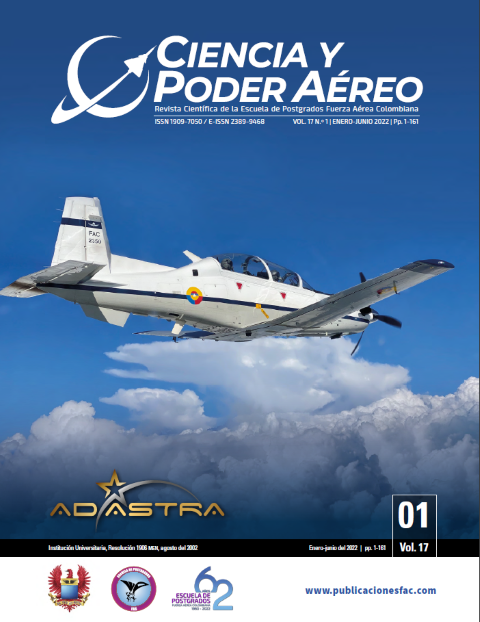Selection of a stage separation system for multistage rockets
DOI:
https://doi.org/10.18667/cienciaypoderaereo.728Keywords:
aerospace, multistage rocket, non-explosive devices, stages, requirements, separation systemsAbstract
The main goal of this research is the selection of a stage separation system that uses non explosive devices as actuators in the liberation event of a multistage rocket. This, in order to reduce both risks and failures during the mission and also in the handling and assembly of these systems on the ground. On the other hand, the research seeks to contribute with the development of the aerospace industry in the country, helping increase the scarce documentation available in these technologies for a future implementation of these systems in Colombia. This, in turn, will allow the use of outer space, for carrying payloads to the different orbits from Colombian territory. The methodology developed was divided into several parts that allowed for the review of the literature in this topic, the wording of the requirements to be met by the system and by means of a screening matrix of three previously selected systems. A system was selected that stands out from others due to its described characteristics and compliance with most of the established requirements.
Downloads
References
Firefly Aerospace. (2019). Alpha Payload User’s Guide. Disponible en: https://firefly.com/wp-content/themes/firefly_aerospace/files/Alpha_PUG_2019-08-30_v2.pdf
Colombia Científica. (2017). Anexo 13 - Niveles de madurez tecnológica. https://minciencias.gov.co/sites/default/files/upload/convocatoria/anexo-13-niveles-madurez-tecnologica-conv.pdf
Boyle, A. (2017). Systima gets a piece of the action for nasa’s Space Launch System Rocket. GeekWire. Disponible en: https://www.geekwire.com/2017/systima-sls-spacelaunch-system-nasa/
Brown, B. (2019). Why do SpaceX Falcon 9 first-stage boosters have a tripod mounted on top? Quora. https://www.quora.com/Why-do-SpaceX-Falcon-9-first-stage-boostershave-a-tripod-mounted-on-top
Cárdenas Córdoba, H. F. y Moncayo Moncayo, F. A. (2008). Diseño del sistema de separación de dos etapas de un cohete para colocar satélites a baja órbita [trabajo de grado, Universidad Autónoma de Occidente]. Repositorio institucional UAO. https://red.uao.edu.co/bitstream/handle/10614/6319/T04331.pdf?sequence=1&isAllowed=y
Chang, I.-S. (2001). Space Launch Vehicle Reliability. Tech- Insider. https://tech-insider.org/related/research/2001/0301.html
COOPER Interconnect. (2012). Non-explosive actuators. http://www.conexionlider.com/jdownloads/COOPER/cooper%20interconnect%20non-explosive%20actuators.pdf
Departamento Nacional de Planeación (DNP). (2020). CONPES 3983-Política de Desarrollo Espacial: condiciones habilitantes para el impulso de la competitividad nacional. DNP.
Duque Peláez, M. (2011). Construcción y lanzamiento de un cohete de dos etapas con alcance sub-estratosférico, misión Séneca III. Proyecto uniandino aeroespacial. https://pua.uniandes.edu.co/doku.php?id=misiones:mision3
Europa Press. (2018, 2 de noviembre). El fallo de un detector provocó el accidente de la Soyuz MS-10. El Tiempo. https://www.eltiempo.com/vida/ciencia/revelan-la-causade-la-falla-en-el-cohete-soyuz-288984
Foust, J. (2020, 4 de julio). Rocket Lab Electron launch fails. Space News. https://spacenews.com/rocket-lab-electronlaunch-fails/
Guinet, V. y Gauthier, B., 2017. RES14BI “Hydra” - a two-stage experimental rocket project within the PERSEUS program. https://eucass.eu/conferences-and-publications/archives/archives-eucass/eucass-2017-milan/eucass-2017-dois-of-full-papers, DOI: 10.13009/EUCASS2017-96
Halligan, R. J. (2014). Requirements quality metrics: The basis of informed requirements engineering management. https://www.ppiint.com/wp-content/uploads/2019/05/Requirements-Quality-Metrics-Paper-with-Addendum-PPA-005330-9-140710.pdf
Katttakuri, V. (2019). Failures in spacecraft systems: An analysis from the perspective of decision making. Purdue University. https://doi.org/10.25394/PGS.9037379.v1
Martens, J., Cui, X., Alacoque, L., Messinger, T., Hamilton, A., Van der Meulen, W. y Deshpande, A. (2018). Student organization for aerospace research Atlantis II. Sounding Rocket. http://www.soundingrocket.org/uploads/9/0/6/4/9064598/43_project_report.pdf.
Mayers, S., Beard, B., Smith, K. y Patterson, A. (2009). Ares i Stage Separation System Design Certification Testing. https://ntrs.nasa.gov/api/citations/20090025949/downloads/20090025949.pdf
Moreno Barón, J. S., Salek Chaves, D. Z. y Peña Cedeño, H. (2016). Diseño conceptual y preliminar de la segunda etapa “Atlas” para el cohete Sonda Libertador i [trabajo de grado, Fundación Universitaria Los Libertadores]. Repositorio institucional Fundación Universitaria Los Libertadores. https://repository.libertadores.edu.co/bitstream/handle/11371/600/MorenoBar%C3%B3nJuan-Sebasti%C3%A1n.pdf?sequence=2&isAllowed=y
National Aeronautics and Space Administration (NASA). (2009). Apollo Spacecraft & Saturn v Launch Vehicle Pyrotechnics/ Explosive Devices. https://ntrs.nasa.gov/archive/nasa/casi.ntrs.nasa.gov/20090015395.pdf.
National Aeronautics and Space Administration (NASA) (1970). nasa Space Vehicle Design Criteria, Flight Separation Mechanisms (nasa sp-8056). https://ntrs.nasa.gov/archive/nasa/casi.ntrs.nasa.gov/19710019510.pdf
Pajoy Ruiz, P. A. y Larrarte Navia, Á. J. (2008). Diseño de un sistema de liberación de un pico satélite de peso un kilogramo, instalado sobre la lanzadera FAC I [trabajo de grado, Universidad Autónoma de Occidente]. Repositorio institucional uao. https://red.uao.edu.co/handle/10614/6322
Patel, N., 2021. Rocket Lab could be SpaceX’s biggest rival. MIT Technology Review. https://www.technologyreview.com/2021/03/02/1020212/rocket-lab-could-be-spacexs-biggest-rival-neutron-falcon-9.
Planetary Systems Corporation. (2014). 2000785F MK II MLB User Manual. https://planetarysystemscorp.com/markii-motorized-lightband/
SpaceX. (2017). World’s First Reflight of an Orbital Class Rocket | SES-10 Hosted Webcast [video]. YouTube. https://www.youtube.com/watch?v=xsZSXav4wI8&t=1829s
SpaceX. (2020a). Falcon User’s Guide. https://www.spacex.com/media/Falcon_Users_Guide_082020.pdf
SpaceX. (2020b). Starship Users Guide. https://www.spacex.com/media/starship_users_guide_v1.pdf
Systima Technologies Inc. (2013). Low shock rocket body separation. https://patentimages.storage.googleapis.com/9e/08/ea/feb2efcb90afee/US8607705.pdf
Systima Technologies Inc. (2019). Systima Recognized by Firefly Aerospace for Stage Separation System. https://www.systima.com/blog/systima-recognized-by-firefly-aerospace-for-stage-separation-system/
Systima Technologies Inc. (s. f.). Systima Technologies Inc. Disponible en: https://www.sbir.gov/sites/default/files/SBAsuccess_Systima.pdf
Torres Amézquita, J. D. (2018). Diseño y construcción de un prototipo de segunda generación para separación de etapas en vehículos aeroespaciales [trabajo de grado, Universidad de los Andes]. Repositorio institucional Uniandes. https://repositorio.uniandes.edu.co/handle/1992/40438
Yoon, D. [@DavidKYoon]. (2015, 15 de enero). The radial axial (RADAX) joints for the sounding rocket came out sexy [imagen] [tuit]. Twitter. https://twitter.com/DavidKYoon/status/555148470843998209/photo/1
Downloads
Published
Issue
Section
Categories
License
Copyright (c) 2022 Escuela de Postgrados de la Fuerza Aérea Colombiana

This work is licensed under a Creative Commons Attribution 4.0 International License.
Assignment of Copyrights
Authors assign Ciencia y Poder Aéreo journal the exclusive rights (reproduction, distribution, public communication, and transformation) to exploit and commercialize their work, in whole or in part, in all the formats and modalities of present or future exploitation, in all languages, throughout the life of the work and throughout the world.
All contents published in Ciencia y Poder Aéreo journal are licensed under a Creative Commons Attribution 4.0 International License, whose complete information is available at http://creativecommons.org/licenses/by/4.0/
Under the terms of this license, users are free to download, print, extract, archive, distribute and publicly communicate the content of articles, provided that proper credit is granted to authors and Ciencia y Poder Aéreo, scientific journal of the Graduate School of the Colombian Air Force. Except when otherwise indicated, this site and its contents are licensed under a Creative Commons Attribution 4.0 International License.
For other uses not considered under this license it is required to contact the Director or the Editor of the journal at the e-mail address cienciaypoderaereo1@gmail.com.
The Graduate School of the Colombian Air Force and this publication are not responsible for the concepts expressed in the articles, including the metadata or the affiliation stated by authors. This is the full responsibility of the authors.






















